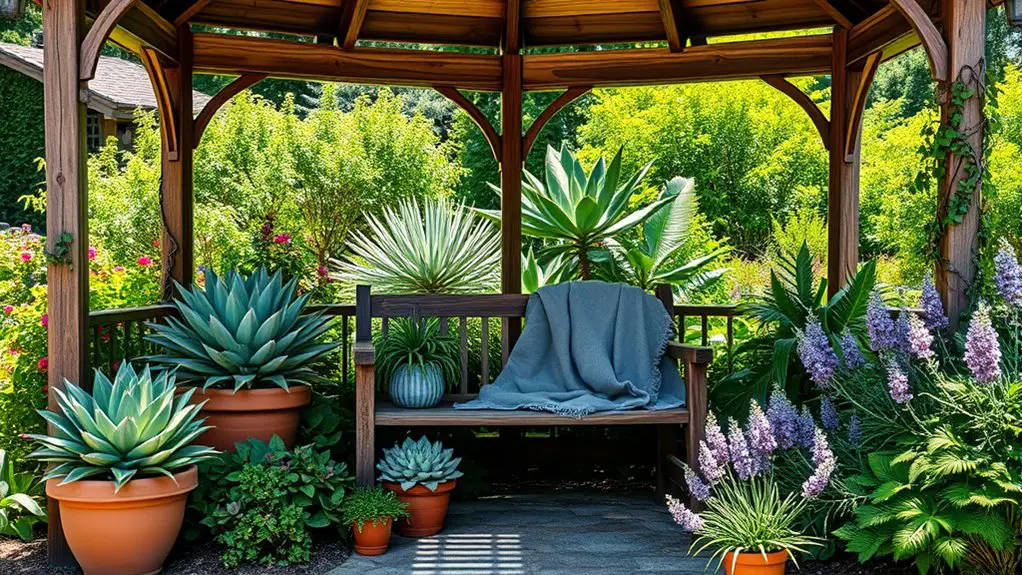For your gazebo garden, consider hardy perennials like coneflowers and black-eyed Susans for seasonal blooms, as well as drought-resistant plants like agave and sedum that thrive with minimal watering. Incorporate colorful annuals such as petunias and marigolds for vibrant displays, and fragrant herbs like lavender and rosemary for both aroma and pest control. Mixing in diverse foliage plants adds texture and visual interest. Discover more options to create a stunning landscape that requires little maintenance.
Hardy Perennials for Year-Round Beauty
When you’re looking to create a gazebo garden that thrives year-round, incorporating hardy perennials is crucial. These plants not only provide vibrant seasonal blooms, but they also offer the resilience needed to withstand changing weather conditions. Focus on native plants, as they require less maintenance and are well-adapted to your local climate. Consider varieties like coneflowers, black-eyed Susans, and daylilies, which bring striking color and attract pollinators. Additionally, incorporating plants like sedum and hostas can enhance the garden’s visual appeal throughout the seasons. By selecting a diverse array of hardy perennials, you’ll guarantee your gazebo garden remains a lush, inviting space, allowing you the freedom to enjoy nature’s beauty without constant upkeep. Furthermore, it’s essential to ensure adequate watering practices for these perennials to thrive throughout the year.
Drought-Resistant Plants That Flourish
In addition to hardy perennials, incorporating drought-resistant plants can greatly enhance the resilience of your gazebo garden. These plants require minimal watering and can thrive in harsh conditions, allowing you to enjoy your space without constant upkeep. Consider using drought-tolerant succulents and native desert flora, which are well-adapted to arid environments.
Here’s a quick reference table to help you choose the right plants:
| Plant Type | Characteristics | Water Needs |
|---|---|---|
| Agave | Architectural leaves | Very low |
| Sedum | Varied colors, low-growing | Low |
| Yucca | Tall spikes, striking foliage | Very low |
| Desert Marigold | Bright yellow blooms | Low |
| Aloe Vera | Medicinal properties, fleshy leaves | Low |
These selections will guarantee your gazebo garden stays vibrant with minimal effort.
Colorful Annuals With Minimal Care
Although maintaining a vibrant garden can seem challenging, incorporating colorful annuals that require minimal care can transform your gazebo area without overwhelming you. Consider planting petunias, marigolds, or zinnias, which offer vibrant blooms and thrive with low water needs. These annuals not only add splashes of color but also adapt well to varying conditions, making them ideal for busy gardeners. They typically require deadheading to encourage continuous blooming, but this task is quick and easy. Additionally, using a layer of mulch can help retain moisture, further reducing your watering frequency. By selecting these low-maintenance options, you’ll enjoy a lively and colorful gazebo garden that requires minimal effort, giving you the freedom to relax and appreciate your outdoor space.
Fragrant Herbs to Enhance Your Gazebo
To elevate your gazebo garden experience, incorporating fragrant herbs can create a sensory haven while requiring minimal upkeep. Varieties like lavender, rosemary, and thyme not only emit delightful aromas but also thrive with little attention. These aromatic herbs offer numerous benefits, including pest deterrence and enhanced soil health through herb companion planting. For example, basil can bolster the growth of tomatoes nearby while infusing your space with its sweet scent. Additionally, fragrant herbs can attract beneficial pollinators, enriching your garden’s ecosystem. By selecting low-maintenance options, you’ll enjoy the pleasure of fresh herbs for culinary use and relaxation without the burden of extensive care. Embrace the freedom of gardening with these aromatic companions!
Foliage Plants for Texture and Interest
Incorporating a variety of foliage plants can greatly enhance the texture and visual interest of your gazebo garden. Opt for plants with diverse foliage colors, such as vibrant greens, silvers, or purples, to create a dynamic palette. Consider evergreens like hostas or ferns for consistent structure throughout the year. For seasonal variations, mix in deciduous plants that showcase stunning autumn hues. Plants like Japanese maples offer rich reds and golds come fall. Additionally, the contrasting textures of broad-leaved and fine-leaved plants can create depth and intrigue. By carefully selecting foliage plants, you’ll achieve a low-maintenance garden that captivates the senses and allows you the freedom to enjoy your outdoor space without constant upkeep.
Frequently Asked Questions
What Are the Best Planting Times for Low-Maintenance Plants?
You’d think plants would thrive any time, right? Wrong! For low-maintenance treasures, focus on spring planting for robust growth, or fall planting for a tranquil winter prep. Timing’s key, so don’t underestimate it!
How Do I Prepare the Soil for My Gazebo Garden?
To prepare your soil, start with soil testing to determine nutrient levels. Then, incorporate compost application to enrich the soil, enhancing drainage and fertility. This’ll create an ideal foundation for your plants to thrive.
Are There Any Pest Control Tips for Low-Maintenance Plants?
For pest control, consider introducing natural predators like ladybugs or lacewings. You can also use organic solutions such as neem oil or insecticidal soap, which effectively manage pests without harming your low-maintenance plants or the environment.
Can I Grow Low-Maintenance Plants in Containers?
Yes, you can absolutely grow low-maintenance plants in containers. For effective container gardening, focus on plant selection that thrives in confined spaces, ensuring proper drainage and suitable soil to minimize upkeep and maximize enjoyment.
How Often Should I Water My Gazebo Garden Plants?
Like a thirsty traveler in the desert, your plants need consistent hydration. Generally, check soil moisture and water every 1-2 weeks, adjusting for weather. Proper watering frequency guarantees ideal plant hydration and health.

